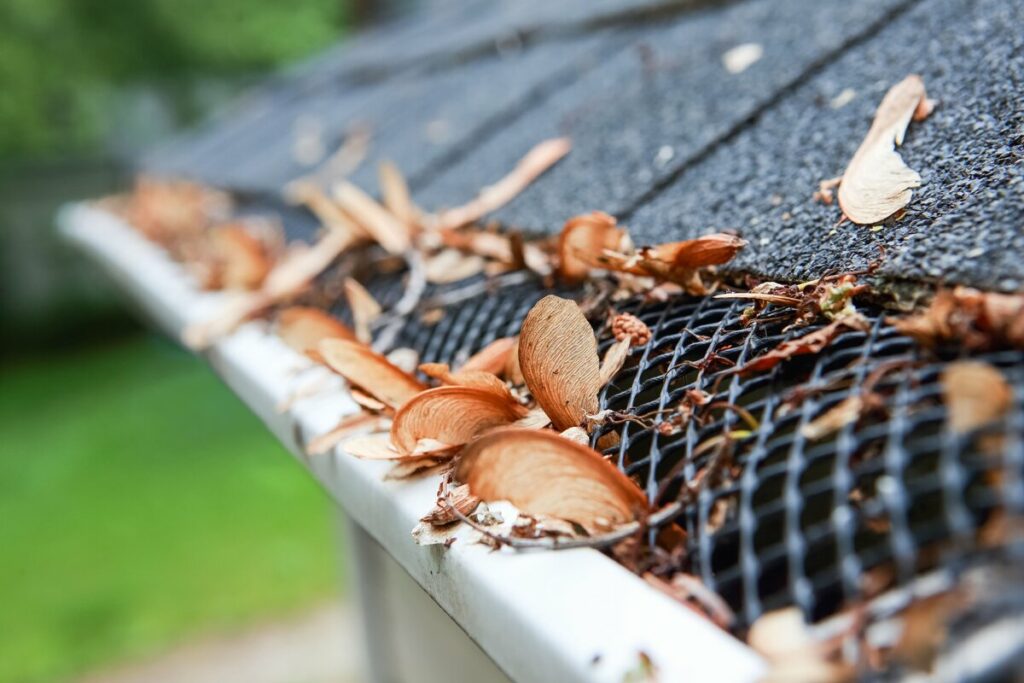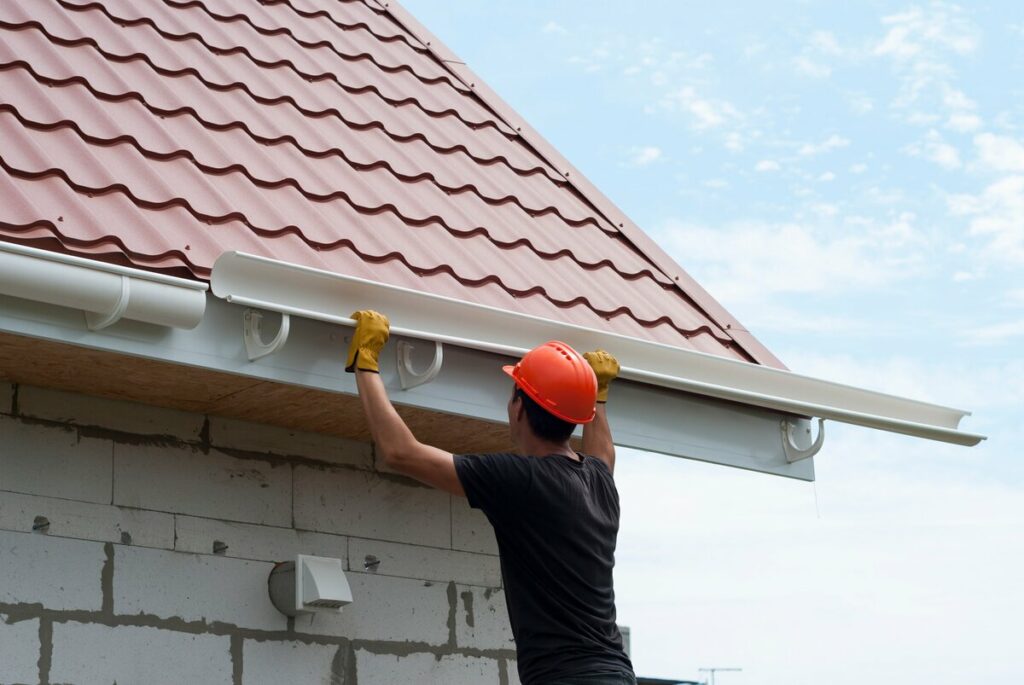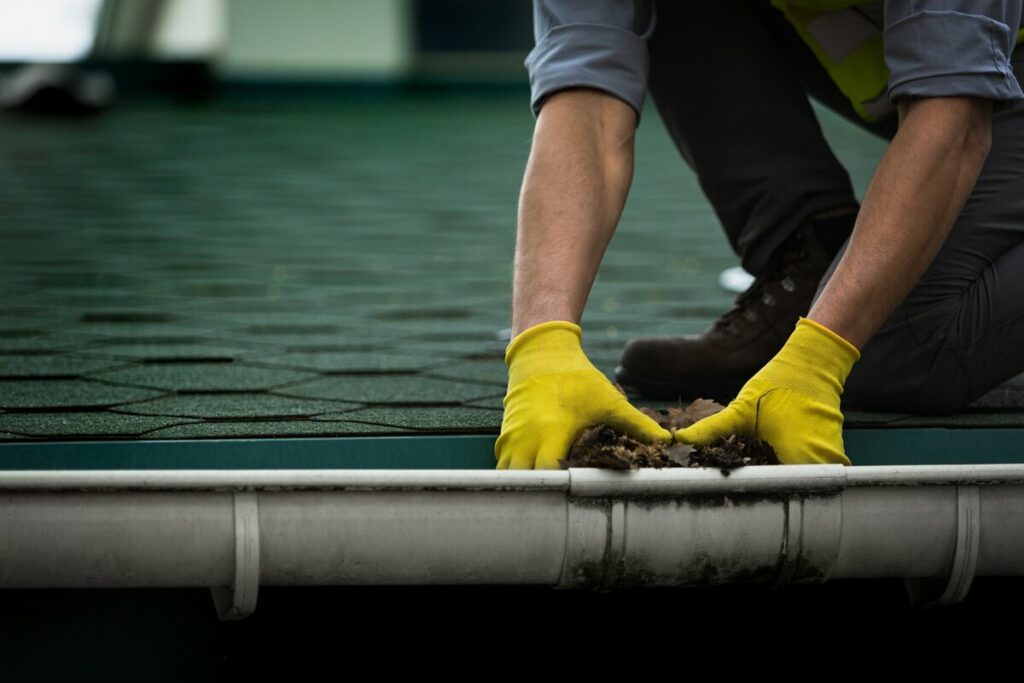Gutters are used to funnel rain and snow away from your home’s foundation, which helps to protect the home from water damage. It also help to keep the landscaping around the home looking nice and healthy by preventing excess water from pooling in certain areas.
In some areas of the country, the precipitation and homebuilding practices make gutters a virtual necessity. In other regions – especially those with drier climates, fast-draining soil, or no basements – gutters are more of an option.
The decision of whether to have gutters on your home is, obviously, up to the homeowner and should be made in consultation with a builder, roofing contractor, or other homebuilding professional. Since water can cause serious damage, you should consider all the pros and cons of having gutters installed before making a decision.
Types of Gutters
Gutters can be made from a variety of materials, including aluminum, vinyl, and galvanized steel.
- Aluminum gutters are the most popular type because they are affordable and durable.
- Vinyl gutters are also popular because they are low maintenance and resistant to rust and decay.
- Galvanized steel gutters are more expensive than other types of gutters, but they are very strong and can withstand harsh weather conditions.
- Copper gutters offer a very distinctive design style, but are the most expensive.
- There are a few different styles of gutters that can be installed on a home:
The most common type is the eavestrough, which is a long, narrow gutter that hangs along the edge of the roof. - Box gutters are square or rectangular in shape.
- Half-round gutters are shaped like a half-circle.
Seamless Gutters Versus Seamed Gutters
Gutters can either be joined together in sections or be custom-built and installed without seams.
Seamless gutters are made from one continuous piece of material, while seamed gutters are made from several pieces of material that are joined together. They are less likely to leak than seamed gutters because there are no joints or seams where water can enter.
Seamless gutters also have a more finished look, because the lack of joints creates a cleaner appearance. However, seamless gutters are more expensive than seamed gutters, and they can be more difficult to install. Thus, they are typically built and installed by a professional. Seamed gutters may be a better option for DIYers or those on a budget.
Components of a Gutter-Downspout System
The gutter system on a home consists of the gutters themselves, as well as downspouts, which are pipes that carry water away from the gutters and foundation. The system might also include drainage pipes, which carry water away from the downspouts and into a storm sewer or other type of drainage system.
Many homes have gutter guards or covers, which are installed over them to keep leaves, twigs, and other debris from clogging them. Gutter guards can be made from a variety of materials, including plastic, metal, and mesh.

Should My Home Have Gutters?
Many homeowners find themselves wondering whether or not they should have gutters installed on their homes. There are pros and cons to having gutters, and it really depends on your specific situation as to whether or not they would be beneficial.
PROS OF HAVING GUTTERS
Gutters Can Help Prevent Water Damage to Your Home’s Foundation
If you live in an area with a lot of rainfall, then having gutters installed on your home can help prevent water damage. Gutters direct rainwater away from your home’s foundation, which can help prevent cracks and other issues that can occur when water seeps into your foundation.
Gutters Can Help Prevent Soil Erosion
In heavy rains, a great deal of water runs off your home’s roof, mostly into one spot. This can lead to soil erosion, which can ruin landscaping and potentially cause other problems.
Gutters Can Increase Your Home’s Curb Appeal
They can actually increase your home’s curb appeal—especially if they are made of a material that compliments your home’s exterior (such as copper). If you are planning on selling your home in the near future, then having gutters installed may help you get a higher price for your home.
Gutters Can Direct Water Away From Outdoor Areas
If your home has outdoor living spaces like patios or decks, or if it has extensive landscaping that could be damaged by water runoff, gutters allow you to protect them. For this purpose, it is not necessary to install gutters on the whole house, but rather they can be placed only where needed.
Use a Gutter System to Collect Rainwater
A gutter and downspout system can help direct rainwater into water barrels, which allows you to conserve water for irrigation and landscaping.
CONS OF HAVING GUTTERS
Gutters Can Be Prone to Clogging
Although they can help prevent water damage, they are also prone to clogging. Leaves, twigs, and other debris can easily build up in your gutters, which can cause them to overflow and/or to break entirely. If you do choose to have gutters installed on your home, then you will need to make sure that you regularly clean them out to prevent clogs.
Gutters Can Be Difficult and Expensive to Install/Maintain
Another con to having gutters is that they can be difficult and expensive to install (especially if your home does not already have them). Not only do you have to pay for the materials and labor necessary to install the gutters, but you also have to pay for regular gutter cleaning and maintenance. If you are not prepared to budget for these additional costs, then having gutters installed may not be the right choice for you.

Gutter Installation
Gutters can be installed by a roofing contractor as part of a roof replacement or new roof installation, but they can also be installed at any time. Installing gutters can be a fairly straightforward process in homes with a basic gable roof, but it can become much more complicated if the roof has different angles. It is often more cost-effective to hire a professional roofing contractor or gutter installer than to attempt to do it yourself.
To serve their purpose effectively, gutters have to drain properly, which means that they need to have a certain slope. Too little slope can allow water to pool in the gutters, and too much can cause an overflow of water at the end. It is generally recommended that gutters should slope about 1/2 inch for every 10 feet. Gutter runs that are longer than 40 feet may need to have the gutter pitched down from the middle to either side.
Placement of gutters is also important, since putting them too close will allow rainwater to run over them, but placing them too far might permit water to flow behind. It is generally recommended to have gutters installed 2″ – 3″ below the roofline.
The location of downspouts should also be considered. Downspouts should be positioned so that they direct water away from your home’s foundation. Extensions can be used if needed, or, in some cases, the downspout can be connected to an underground pipe that leads to the city’s sewer system.
Here are the basic steps involved in gutter installation:
- The first step is to remove the old gutters and inspect the fascia to ensure that it is in good condition.
- Mark out the slope from the highest point to the lowest.
- Attach fascia brackets or hangers, making sure they are evenly spaced.
- Next, measure the length of the area where the new gutters will be installed and cut them to size.
- Attach end caps.
- Cut holes for downspouts.
- Attach the gutters to the hangers and check that they are level before securing them in place.
- Install downspouts and add extensions if needed.
If the roof has multiple angles, it will be necessary to join parts of the gutter together. This sometimes involves cutting angles, which can be tricky for anyone without experience.

Gutter Maintenance
Much like roof maintenance, gutters need to be regularly cleaned out to prevent clogs, which can cause water damage. This is generally a task that needs to be done at least once a year, but more often if you live in an area with a lot of trees.
Cleaning gutters can be tricky and dangerous since you will need to use a ladder. If you are not comfortable doing this yourself, then you can hire a professional gutter cleaning service.
To clean your gutters, start by removing any visible debris from the ground. Then, use a ladder to reach the gutters and remove any remaining leaves, twigs, and other debris. Once the gutters are clear, flush them out with water to check for any leaks.
If you notice any leaks, then you will need to repair them. First, try caulking around the leaky area. If that does not work, then you may need to replace that section of the gutter.
After your gutters are clean and repaired, you can install gutter guards to help prevent debris from getting in and causing clogs in the future. Gutter guards come in a variety of shapes and sizes, so you will need to choose the type that is best suited for your gutters.
Gutter Terminology
- Box gutters – These are rectangular in shape and are most commonly found on older homes
- Half-round gutters – These have a semicircular cross-section and can be made from either plastic or metal
- K-style gutters – Also called Ogee or OG, these have a flat bottom with decorative edges on the sides
- Fascia gutters – These are installed underneath the fascia board (the horizontal board that runs along the edge of your roof)
- Seamless gutters – These are custom-made to fit your home’s specific dimensions and do not have any seams or joints
- Gutter guards – These help to keep leaves and other debris out of your gutter system
There are both pros and cons to having gutters installed on your home. It really depends on your specific situation as to whether or not they would be beneficial for you.
Stronghold Roofing & Solar In Central Florida
When you need roofing services, contact the best roofing company in Florida.
Our Lakeland roofing company has a team of experienced roofers who are committed to providing the best quality workmanship and customer service. We offer a full range of residential and commercial roofing services, roof financing, and free estimates.
Contact Stronghold Roofing and Solar today.










